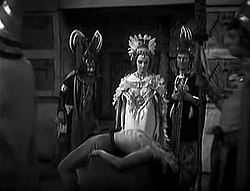| 006 –The Aztecs | |||
|---|---|---|---|
| Doctor Who serial | |||
 Barbara Wright (Jacqueline Hill), mistaken for Aztec goddess Yetaxa, reluctantly prepares for a human sacrifice. Critics praised the historical accuracy and Hill's performance. [1] [2] [3] | |||
| Cast | |||
Others
| |||
| Production | |||
| Directed by | John Crockett | ||
| Written by | John Lucarotti | ||
| Script editor | David Whitaker | ||
| Produced by | Verity Lambert | ||
| Music by | Richard Rodney Bennett | ||
| Production code | F | ||
| Series | Season 1 | ||
| Running time | 4 episodes, 25 minutes each | ||
| First broadcast | 23 May 1964 | ||
| Last broadcast | 13 June 1964 | ||
| Chronology | |||
| |||
The Aztecs is the sixth serial of the British science fiction television series Doctor Who , which was first broadcast on BBC1 in four weekly parts from 23 May to 13 June 1964. It was written by John Lucarotti and directed by John Crockett. In the serial, the First Doctor (William Hartnell), his granddaughter Susan (Carole Ann Ford), and teachers Ian Chesterton (William Russell) and Barbara Wright (Jacqueline Hill) arrive in Mexico during the Aztec empire. Barbara becomes mistaken for the goddess Yetaxa, and accepts the identity in hope of persuading the Aztecs to give up human sacrifice, despite the Doctor's warnings about changing history.
Contents
- Plot
- Production
- Conception and writing
- Casting and characters
- Filming
- Reception
- Broadcast and ratings
- Critical response
- Commercial releases
- In print
- Home media
- Notes
- References
- Bibliography
- External links
Lucarotti became fascinated by the Aztec civilisation while living in Mexico, largely due to the Aztec tradition of human sacrifice. He wrote the episodes while his other serial, Marco Polo , was in production. Designer Barry Newbery based his set designs on books and documentaries about the Aztecs, though faced difficulty due to the limited information on the civilisation available. Costume designer Daphne Dare used artistic licence with the serial's costumes, due to the limited clothing worn by the Aztecs. The serial premiered with 7.9 million viewers, maintaining audience figures throughout the four weeks. Response for the serial was positive, and it has since been described as one of the show's greatest stories. It later received several print adaptations and home media releases.

